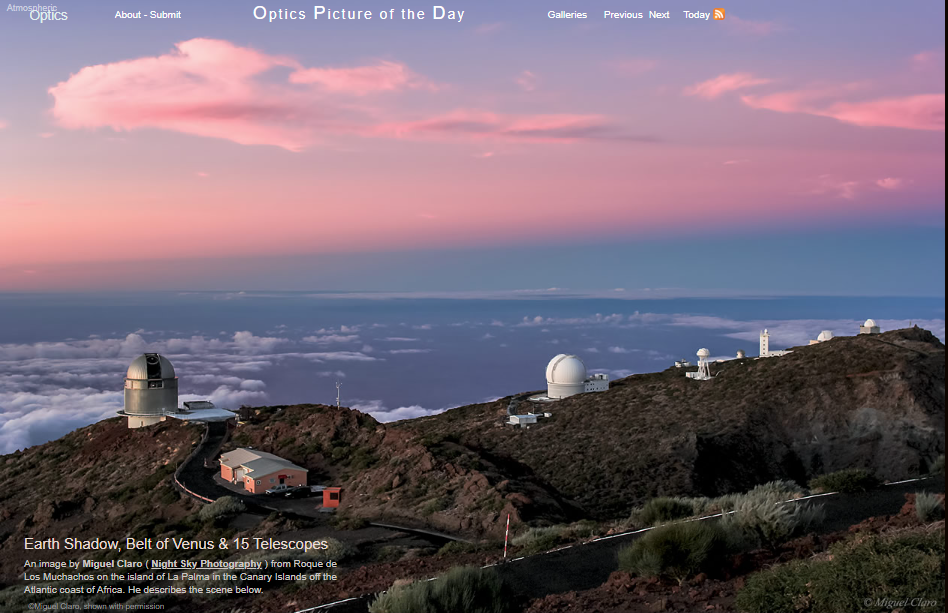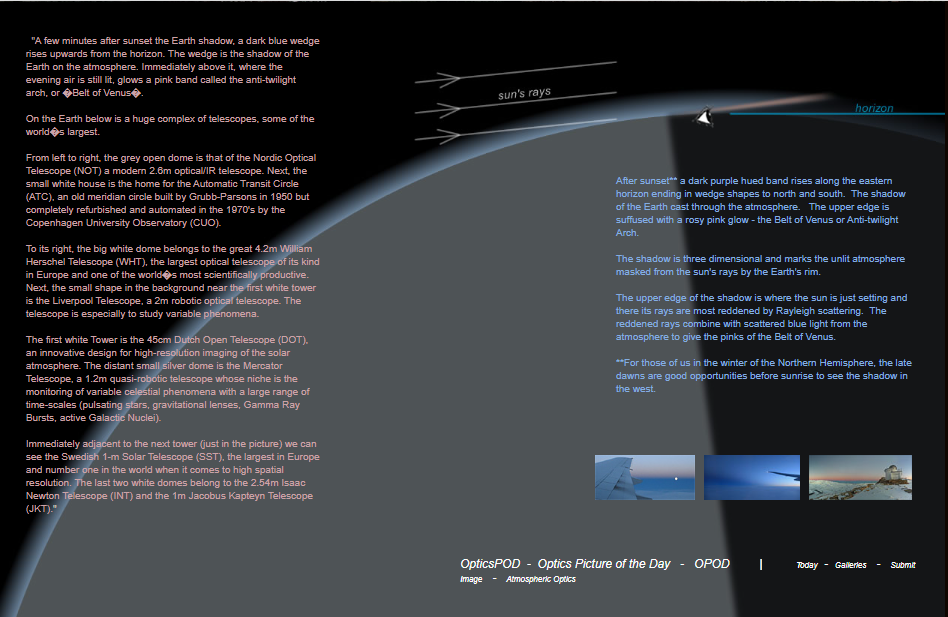Shadows and telescopes - OPOD
Shadows and Telescopes: A Spectacular Display in the Canary Islands
The breathtaking images captured by Miguel Claro from Roque de Los Muchachos on the island of La Palma in the Canary Islands offer a mesmerizing glimpse into the atmospheric optics phenomenon known as the Earth shadow. This captivating spectacle occurs just moments after sunset when a dark blue wedge gracefully ascends from the horizon. This wedge is the Earth's shadow cast upon the atmosphere. Immediately above it, a delicate pink band, aptly named the "Belt of Venus" or the anti-twilight arch, adorns the evening sky.
But what makes this scene even more remarkable is the presence of a vast complex of telescopes dotting the landscape. These telescopes, some of the largest in the world, add a touch of scientific grandeur to the already awe-inspiring natural phenomenon.
Let's take a closer look at these remarkable telescopes and their contributions to our understanding of the universe:
-
Nordic Optical Telescope (NOT): The grey open dome houses the Nordic Optical Telescope, a state-of-the-art 2.6m optical and infrared telescope. It serves as a crucial tool for astronomers studying various celestial objects and phenomena.
-
Automatic Transit Circle (ATC): Adjacent to the NOT, you'll find a small white house that serves as the home for the Automatic Transit Circle. Originally built in 1950 by Grubb-Parsons, this meridian circle underwent a complete refurbishment and automation process in the 1970s by the Copenhagen University Observatory (CUO).
-
William Herschel Telescope (WHT): Dominating the scene with its big white dome is the William Herschel Telescope. With a diameter of 4.2m, it stands as Europe's largest optical telescope of its kind and remains one of the most scientifically productive telescopes worldwide.
-
Liverpool Telescope: Positioned near the first white tower, the Liverpool Telescope is a 2m robotic optical telescope specifically designed to study variable celestial phenomena. Its automated capabilities make it an invaluable asset for observing transient events in the night sky.
-
Dutch Open Telescope (DOT): The first white tower is home to the 45cm Dutch Open Telescope, an innovative design optimized for high-resolution imaging of the solar atmosphere. Its unique features enable scientists to capture detailed observations of our nearest star.
-
Mercator Telescope: In the distance, you'll spot a small silver dome housing the Mercator Telescope. This quasi-robotic telescope boasts a 1.2m diameter and specializes in monitoring variable celestial phenomena across a wide range of time scales, including pulsating stars, gravitational lenses, Gamma Ray Bursts, and active Galactic Nuclei.
-
Swedish 1-m Solar Telescope (SST): Adjacent to the next tower, the Swedish 1-m Solar Telescope stands tall as the largest solar telescope in Europe and holds the top position globally in terms of high spatial resolution capabilities. It plays a crucial role in unraveling the mysteries of our Sun.
-
Isaac Newton Telescope (INT): The penultimate white dome belongs to the 2.54m Isaac Newton Telescope. This powerful optical telescope has contributed significantly to our understanding of various astronomical phenomena since its installation.
-
Jacobus Kapteyn Telescope (JKT): Finally, we have the 1m Jacobus Kapteyn Telescope, represented by the last two white domes. This telescope has played a vital role in astronomical research and continues to contribute to our knowledge of the universe.
As darkness descends and the sun dips below the horizon, a magnificent display unfolds along the eastern sky. A dark purple-hued band rises from the horizon, gradually transforming into wedge shapes to the north and south. This striking phenomenon represents the three-dimensional shadow of the Earth cast through the atmosphere. The upper edge of the shadow, suffused with a rosy pink glow, is famously known as the Belt of Venus or Anti-twilight Arch.
The Earth's shadow marks the unlit portion of the atmosphere shielded from direct sunlight by the Earth's rim. As the sun sets, its rays pass through a greater portion of the Earth's atmosphere, leading to increased scattering of shorter blue wavelengths and resulting in the reddening of the sunlight. This reddened light combines with the scattered blue light to create the enchanting pink hues of the Belt of Venus.
For those residing in the winter months of the Northern Hemisphere, the late dawns present an excellent opportunity to witness this captivating shadow in the west before sunrise. It is a moment of tranquility and wonder, where nature and scientific discovery converge to create a truly magical experience.
Please note that this article has been automatically converted from the old site and may not appear as originally intended. To access the original article, you can visit here.
So, next time you find yourself gazing at the sky during sunset or sunrise, take a moment to appreciate the interplay between light, shadow, and our remarkable telescopes that continue to unravel the mysteries of our universe.

Earth Shadow, Belt of Venus & 15 Telescopes
An image by Miguel Claro ( Night Sky Photography ) from Roque de Los Muchachos on the island of La Palma in the Canary Islands off the Atlantic coast of Africa. He describes the scene below.
©Miguel Claro, shown with permission

"A few minutes after sunset the Earth shadow, a dark blue wedge rises upwards from the horizon. The wedge is the shadow of the Earth on the atmosphere. Immediately above it, where the evening air is still lit, glows a pink band called the anti-twilight arch, or �Belt of Venus�.
On the Earth below is a huge complex of telescopes, some of the world�s largest.
From left to right, the grey open dome is that of the Nordic Optical Telescope (NOT) a modern 2.6m optical/IR telescope. Next, the small white house is the home for the Automatic Transit Circle (ATC), an old meridian circle built by Grubb-Parsons in 1950 but completely refurbished and automated in the 1970's by the Copenhagen University Observatory (CUO).
To its right, the big white dome belongs to the great 4.2m William Herschel Telescope (WHT), the largest optical telescope of its kind in Europe and one of the world�s most scientifically productive.
Next, the small shape in the background near the first white tower is the Liverpool Telescope, a 2m robotic optical telescope. The telescope is especially to study variable phenomena.
The first white Tower is the 45cm Dutch Open Telescope (DOT), an innovative design for high-resolution imaging of the solar atmosphere. The distant small silver dome is the Mercator Telescope, a 1.2m quasi-robotic telescope whose niche is the monitoring of variable celestial phenomena with a large range of time-scales (pulsating stars, gravitational lenses, Gamma Ray Bursts, active Galactic Nuclei).
Immediately adjacent to the next tower (just in the picture) we can see the Swedish 1-m Solar Telescope (SST), the largest in Europe and number one in the world when it comes to high spatial resolution. The last two white domes belong to the 2.54m Isaac Newton Telescope (INT) and the 1m Jacobus Kapteyn Telescope (JKT)."
After sunset.. a dark purple hued band rises along the eastern horizon ending in wedge shapes to north and south. The shadow of the Earth cast through the atmosphere. The upper edge is suffused with a rosy pink glow - the Belt of Venus or Anti-twilight Arch.
The shadow is three dimensional and marks the unlit atmosphere masked from the sun's rays by the Earth's rim.
The upper edge of the shadow is where the sun is just setting and there its rays are most reddened by Rayleigh scattering. The reddened rays combine with scattered blue light from the atmosphere to give the pinks of the Belt of Venus.
..For those of us in the winter of the Northern Hemisphere, the late dawns are good opportunities before sunrise to see the shadow in the west.
Note: this article has been automatically converted from the old site and may not appear as intended. You can find the original article here.
Reference Atmospheric Optics
If you use any of the definitions, information, or data presented on Atmospheric Optics, please copy the link or reference below to properly credit us as the reference source. Thank you!
-
<a href="https://atoptics.co.uk/blog/shadows-and-telescopes-opod/">Shadows and telescopes - OPOD</a>
-
"Shadows and telescopes - OPOD". Atmospheric Optics. Accessed on April 19, 2024. https://atoptics.co.uk/blog/shadows-and-telescopes-opod/.
-
"Shadows and telescopes - OPOD". Atmospheric Optics, https://atoptics.co.uk/blog/shadows-and-telescopes-opod/. Accessed 19 April, 2024
-
Shadows and telescopes - OPOD. Atmospheric Optics. Retrieved from https://atoptics.co.uk/blog/shadows-and-telescopes-opod/.